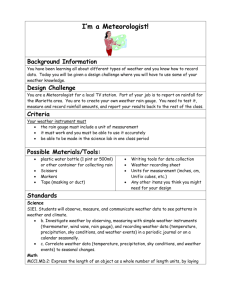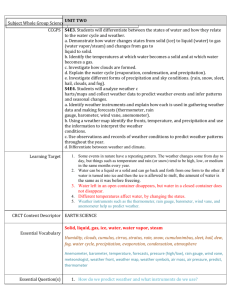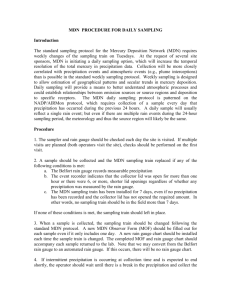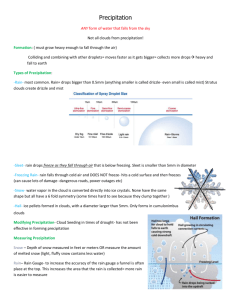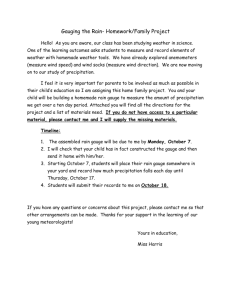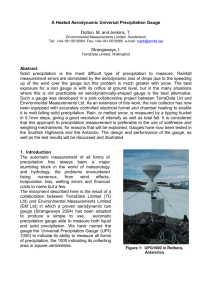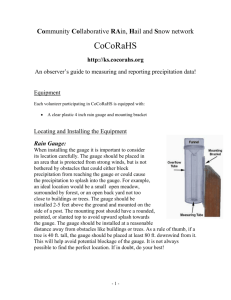Monitoring Protocol
advertisement
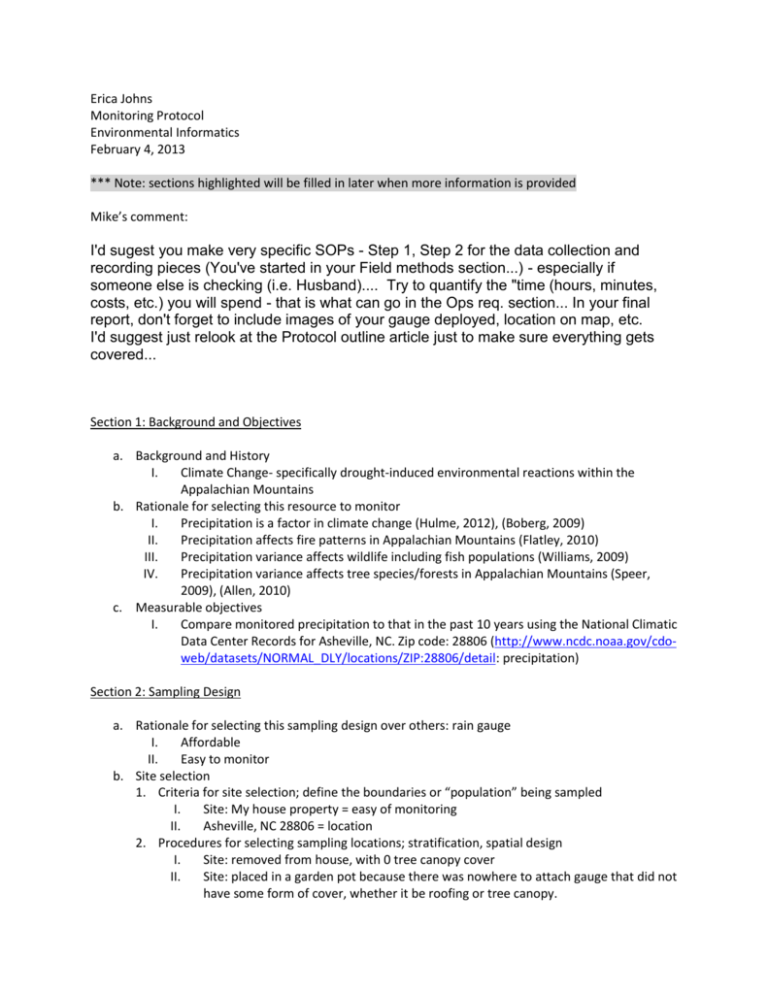
Erica Johns Monitoring Protocol Environmental Informatics February 4, 2013 *** Note: sections highlighted will be filled in later when more information is provided Mike’s comment: I'd sugest you make very specific SOPs - Step 1, Step 2 for the data collection and recording pieces (You've started in your Field methods section...) - especially if someone else is checking (i.e. Husband).... Try to quantify the "time (hours, minutes, costs, etc.) you will spend - that is what can go in the Ops req. section... In your final report, don't forget to include images of your gauge deployed, location on map, etc. I'd suggest just relook at the Protocol outline article just to make sure everything gets covered... Section 1: Background and Objectives a. Background and History I. Climate Change- specifically drought-induced environmental reactions within the Appalachian Mountains b. Rationale for selecting this resource to monitor I. Precipitation is a factor in climate change (Hulme, 2012), (Boberg, 2009) II. Precipitation affects fire patterns in Appalachian Mountains (Flatley, 2010) III. Precipitation variance affects wildlife including fish populations (Williams, 2009) IV. Precipitation variance affects tree species/forests in Appalachian Mountains (Speer, 2009), (Allen, 2010) c. Measurable objectives I. Compare monitored precipitation to that in the past 10 years using the National Climatic Data Center Records for Asheville, NC. Zip code: 28806 (http://www.ncdc.noaa.gov/cdoweb/datasets/NORMAL_DLY/locations/ZIP:28806/detail: precipitation) Section 2: Sampling Design a. Rationale for selecting this sampling design over others: rain gauge I. Affordable II. Easy to monitor b. Site selection 1. Criteria for site selection; define the boundaries or “population” being sampled I. Site: My house property = easy of monitoring II. Asheville, NC 28806 = location 2. Procedures for selecting sampling locations; stratification, spatial design I. Site: removed from house, with 0 tree canopy cover II. Site: placed in a garden pot because there was nowhere to attach gauge that did not have some form of cover, whether it be roofing or tree canopy. c. Sampling frequency and replication I. Every 24 hours II. 9 am recording d. Recommended number and location of sampling sites I. For the purpose of this project and the amount of rain gauges (1), there is one location. e. Recommended frequency and timing of sampling I. Every 24 hours at 9 am f. Level of change that can be detected for the amount/type of sampling being instituted I. UNKNOWN?? Section 3: Field Methods a. Field season preparations and equipment setup (including permitting and compliance procedures) I. Attention to weather reports- gauge should not be in freezing weather. Pull inside on such occasions. b. Sequence of events during field season I. Note freezing rain or snow events c. Details of taking measurements, with example field forms I. Use metric system: more accurate II. Place rain gauge on flat surface to read measurement correctly III. Pour rain out with each measurement reading IV. Create an access spreadsheet/excel (DO YOU HAVE A RECOMMENDATION? IT SEEMS ACCESS WILL ALLOW FOR BETTER DATA ANALYSIS LATER IN CLASS) that specifies: Day, metric, note d. Post-collection processing of samples (e.g. lab analysis, preparing voucher specimens) I. Comparison of average precipitation, daily precipitation, and winter weather events with previous records from National Climatic Data Center e. End-of-season procedures I. Note seasonal change: i.e. first day of spring, etc. Section 4: Data Handling, Analysis, and Reporting a. Metadata procedures b. Overview of database design c. Data entry, verification, and editing: FROM HERE I WILL MOST LIKELY TRANSLATE METRIC INTO INCHES d. Recommendations for routine data summaries and statistical analyses to detect change e. Recommended reporting schedule f. Recommended report format with examples of summary tables and figures g. Recommended methods for long-term trend analysis (e.g., every 5 or 10 years) h. Data archival procedures Section 5: Personnel Requirements and Training a. Roles and responsibilities I. Erica Johns will take measurements II. On some Thursdays, Erica leaves for UT campus at 7 a.m. on these days the measurement will be taken at 7 a.m. III. If for some reason Erica is unable to take the measurement, her husband will monitor the rain gauge or there will be a note in the ledger b. Qualifications I. In IS 590: Environmental Informatics c. Training procedures I. Show husband where rain gauge is located, how to read the metric side, and the flat surface with which the gauge should be placed for accurate readings. Section 6: Operational Requirements a. Annual workload and field schedule I. Daily for Spring 2013 semester b. Facility and equipment needs I. Rain gauge provided by UT c. Startup costs and budget considerations Section 7: References: Format and Outline: Oakley, Karen L., Lisa P. Thomas, and Steven G. Fancy. "Guidelines for long-term monitoring protocols." Wildlife Society Bulletin (2003): 1000-1003. Background: Allen, Craig D., et al. "A global overview of drought and heat-induced tree mortality reveals emerging climate change risks for forests." Forest Ecology and Management 259.4 (2010): 660-684. Boberg, Fredrik, et al. "Improved confidence in climate change projections of precipitation evaluated using daily statistics from the PRUDENCE ensemble."Climate dynamics 32.7 (2009): 1097-1106. Flatley, William T., Charles W. Lafon, and Henri D. Grissino-Mayer. "Climatic and topographic controls on patterns of fire in the southern and central Appalachian Mountains, USA." Landscape Ecology 26.2 (2011): 195-209. Hulme, Mike. "Estimating global changes in precipitation." Weather 50.2 (2012): 34-42. Speer, James H. Speer JH, et al. "Climate response of five oak species in the eastern deciduous forest of the southern Appalachian Mountains, USA."Canadian journal of forest research 39.3 (2009): 507-518. Williams, Jack E., et al. "Potential consequences of climate change to persistence of cutthroat trout populations." North American Journal of Fisheries Management 29.3 (2009): 533-548. I am thinking access over excel for data so that I may analyze the data later- is this a good thought?


